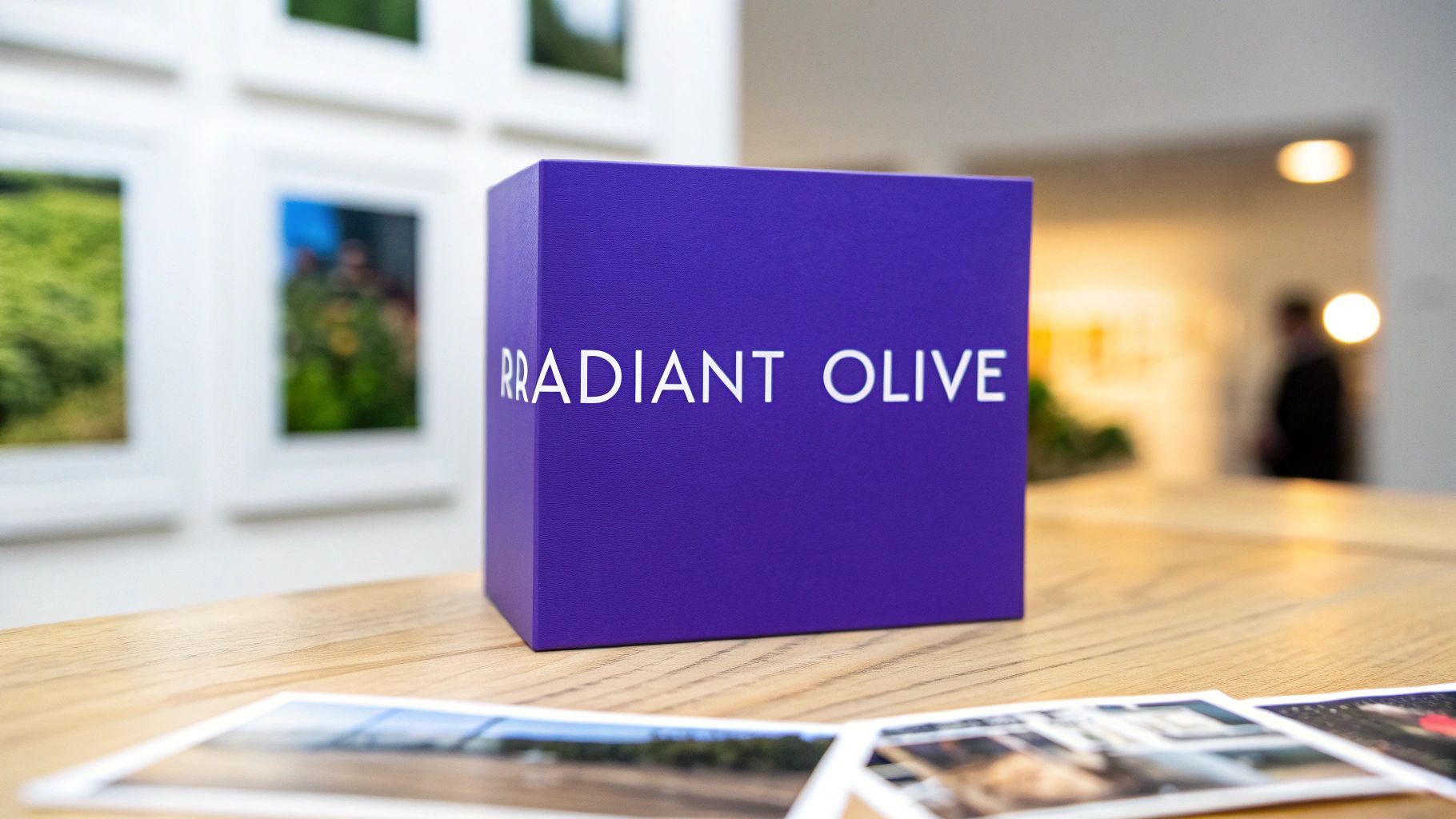
Best Colors for Olive Skin: Top Shades for a Radiant Look
By Emma Johnson - 8/3/2025
Unlocking Your Olive Skin's Radiance
Olive skin, with its beautiful blend of golden and green undertones, has a natural warmth and depth. How can you make the most of this unique complexion? Just as an artist carefully selects colors, understanding which shades complement olive skin can dramatically enhance your appearance. From historical uses of jewel tones to modern color theory, this interplay between skin tone and color has always been key to personal style. The most effective approach? Find colors that harmonize with your undertones to create a vibrant and balanced look.
This goes beyond simply following trends. It's about understanding how color principles interact with your specific complexion.
Eight Flattering Colors for Olive Skin
In this guide, we'll explore eight colors that are particularly stunning on olive skin. Whether you're building a wardrobe, creating a makeup palette, or just looking for a confidence boost, this list will help you unlock your skin's natural radiance. Prepare to discover colors that highlight your complexion and elevate your style.
Burgundy: A Rich Color For Olive Skin
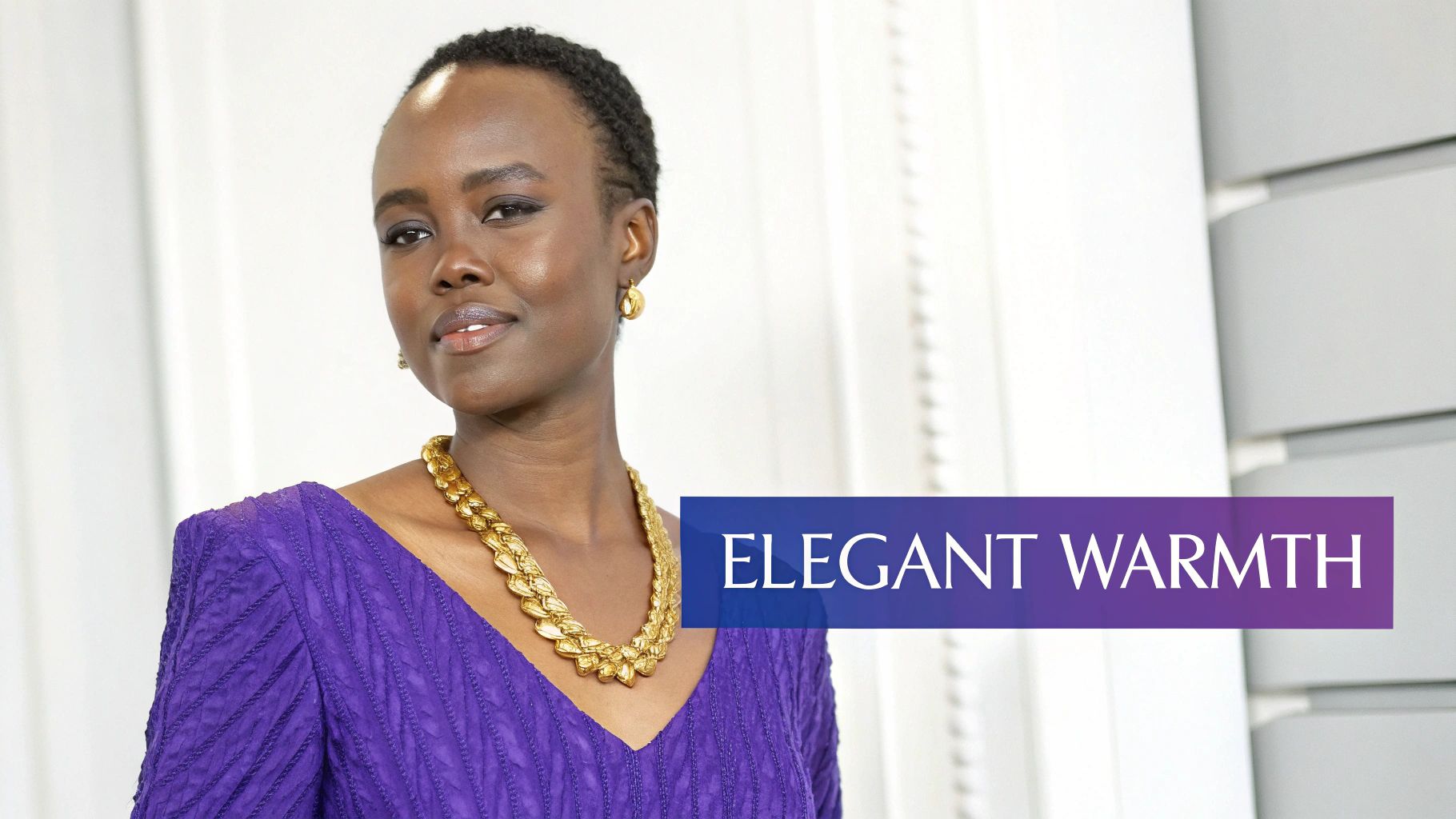
Burgundy, a deep reddish-brown, stands out as a top color choice for olive skin. It enhances natural warmth and contrasts beautifully with greenish undertones. This sophisticated hue adds depth and elegance to any look, making it a versatile choice.
Burgundy's rich tone creates a flattering contrast, bringing out the warmth in olive complexions. This results in a vibrant, healthy appearance. Its versatility across seasons adds to its appeal. While stunning in fall and winter, burgundy can be incorporated into spring and summer wardrobes with lighter fabrics and thoughtful pairings.
Features and Benefits of Burgundy
- Deep Reddish-Brown Hue: Offers a rich and luxurious feel.
- Warmth and Sophistication: Elevates any look without appearing overly flashy.
- Versatility: Adaptable to various fabrics and style combinations throughout the year.
- Complementary to Olive Skin: Enhances the natural complexion by working with green undertones.
Pros and Cons of Wearing Burgundy
Pros:
- Flattering contrast against olive skin
- Enhances natural warmth
- Works year-round
- Adds richness to the overall appearance
Cons:
- Can be overwhelming in large quantities
- Requires confidence to wear
- Needs careful coordination with other colors
Styling Tips and Real-World Examples
Celebrities like Eva Mendes and Penélope Cruz frequently choose burgundy for red carpet events, showcasing its regal qualities. Designer Zac Posen has also featured burgundy in his collections, further highlighting its suitability for olive skin.
Here are some practical styling tips:
- Makeup: Burgundy lipstick creates a classic evening look. Experiment with burgundy eyeshadow for added drama.
- Clothing: A burgundy dress can be incredibly elegant. If you're hesitant, start with accessories like scarves, belts, or handbags to accent neutral outfits.
- Jewelry: Pair burgundy with gold jewelry to enhance warmth and create a luxurious feel.
- Color Coordination: Balance burgundy with neutrals like beige, cream, or white for a polished and balanced look. This prevents the color from becoming overpowering.
Whether you’re building your style confidence or exploring new trends, burgundy is a color that deserves a place in your wardrobe and makeup bag. Its flattering effect on olive skin, combined with its versatility and sophistication, makes it a true style staple.
2. Emerald Green
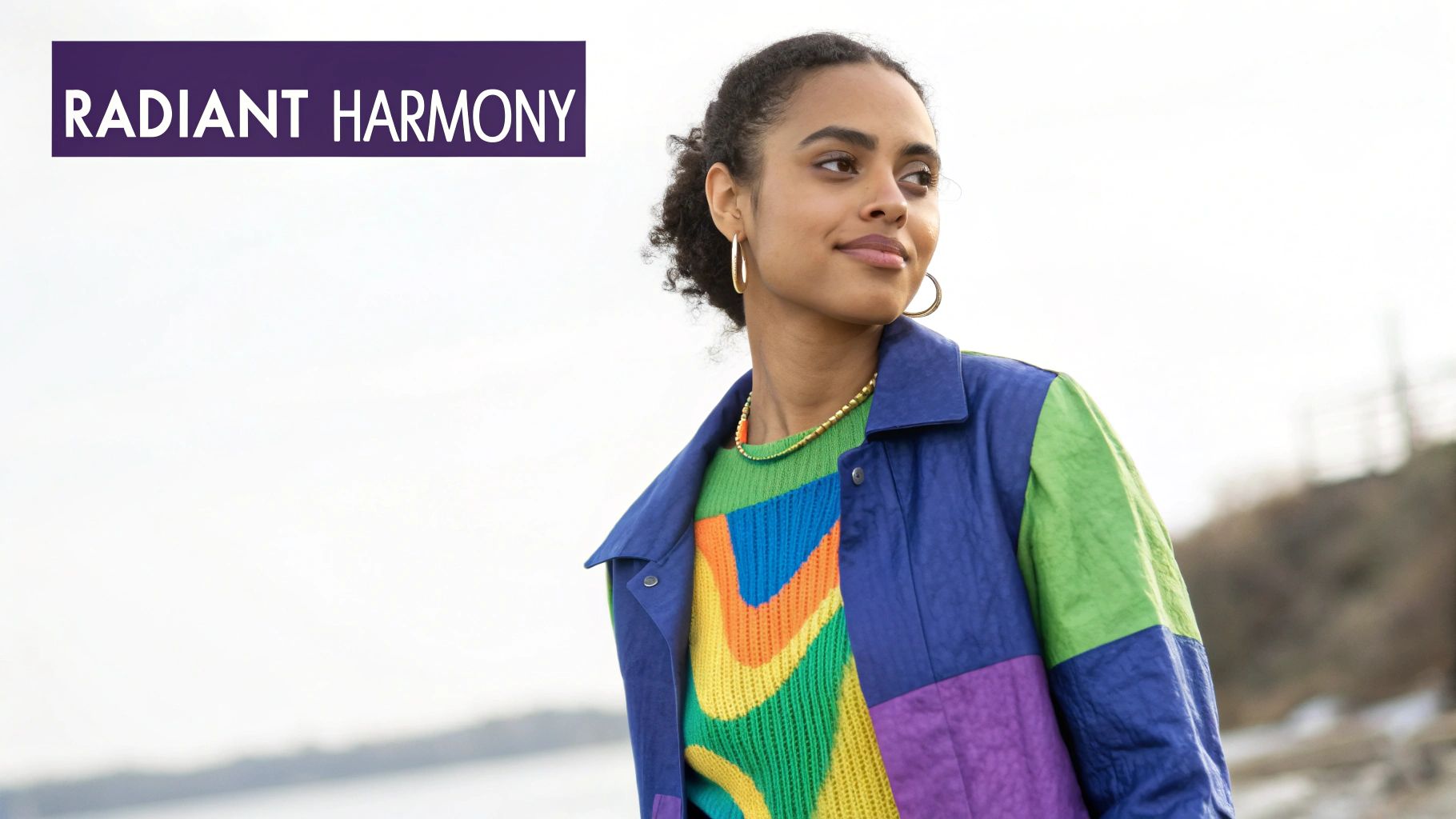
Emerald green is a stunning choice for olive skin tones. Its ability to complement underlying warm hues makes it a standout. This jewel tone, with its subtle blue undertones, doesn't overpower the warmth of olive skin. Instead, it enhances it.
Emerald green brings out the golden qualities, creating a radiant look. This effect comes from the green undertones present in olive skin, making a natural pairing with emerald.
Emerald green offers a variety of intensities, from medium to deep. This versatility makes it adaptable for different occasions. A deep emerald evening gown or a subtle emerald green eyeliner can both elevate your style. For further exploration of color palettes, consider this Color Analysis: A Perfect Palette Guide.
Features and Benefits
- Rich Jewel Tone With Blue Undertones: This provides depth and a sophisticated feel.
- Harmonizes With Olive Skin's Natural Undertones: Emerald green creates a flattering, balanced look.
- Luxurious and Vibrant Appearance: This adds a touch of elegance to any outfit or makeup look.
Pros
- Enhances Natural Glow: Emerald green accentuates the warmth and golden undertones of olive skin.
- Creates a Harmonious Look: It complements rather than clashes with the complexion.
- Versatile Application: This color works well in clothing, accessories, and makeup.
- Suitable for All Seasons: It's especially striking during the winter months.
Cons
- Can Be Challenging to Pair: Coordinating with other colors requires careful planning.
- May Clash With Certain Hair Colors: Balance is essential for a successful look.
- Premium Pricing: High-quality emerald green fabrics can be expensive.
Real-World Examples and Case Studies
Many olive-skinned celebrities, such as Salma Hayek, often wear emerald green. Designer Elie Saab also features this color in his collections, highlighting its suitability for Mediterranean complexions. In the beauty industry, makeup artist Pat McGrath has showcased emerald eye looks on olive-skinned models, demonstrating how it intensifies brown eyes.
Tips for Implementation
- Wear Near the Face: This maximizes the color's impact, enhancing your golden undertones.
- Emerald for Eyes: Try emerald eyeliner or eyeshadow to bring out the richness of brown eyes.
- Accessorize With Gold or Bronze: These metallics pair beautifully with emerald green.
- Choose True Emerald: Opt for pure emerald shades over yellow-green variations for the best effect.
Emerald green’s growing popularity is thanks to fashion designers and makeup artists. They recognize its flattering effect on olive skin. By understanding how color interacts with complexion, you can use emerald green to create stunning looks. For more in-depth information on color theory, see this Color Analysis: A Perfect Palette Guide.
Coral: A Vibrant Hue for Olive Skin
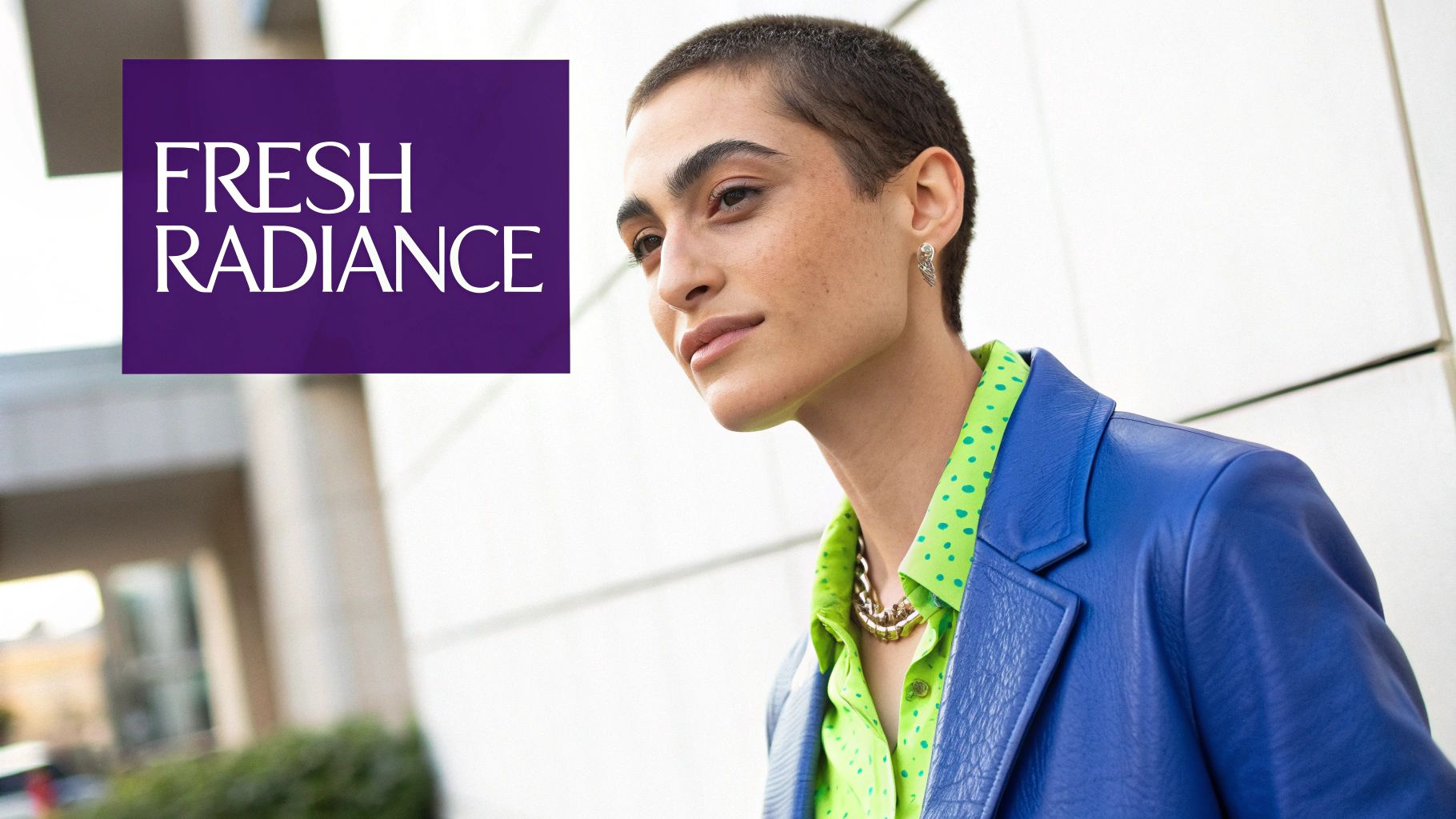
Coral, a warm color between pink and orange, is a fantastic choice for olive skin tones. Its brightening qualities enhance the complexion, adding a healthy flush that combats any dullness. This makes coral a versatile color suitable for any season, from summer dresses to winter coats.
One of coral's key attributes is its warm, peachy-pink undertone. This warmth complements the green undertones in olive skin, creating a balanced look. This balance brings out a healthy glow. Coral comes in various shades, from subtle hues to bold statements, allowing people with different olive complexions to find their ideal match.
Pros of Wearing Coral
- Gives olive skin a healthy radiance
- Balances and brightens green undertones
- Creates a youthful, fresh look
- Suits both summer and winter wardrobes
Cons of Wearing Coral
- Intense corals can be overwhelming for some olive complexions.
- May clash with certain lip colors without careful coordination.
- Might require adjustments to other makeup for a harmonious look.
For example, a coral blush provides a natural-looking flush, while a coral sundress is ideal for summer. Coral lipstick brightens the face and can even make teeth appear whiter. Celebrities like Jennifer Lopez and Jessica Alba, known for their olive skin, often wear coral. NARS's 'Orgasm' blush, a coral-peach shade, is a cult favorite recommended for olive skin.
Tips for Using Coral
- Fairer Olive Skin: Select softer coral shades.
- Deeper Olive Tones: Choose vibrant, saturated corals.
- Clothing: Pair coral pieces with neutral accessories.
- Blush: Apply coral blush high on the cheekbones for a sun-kissed look.
- Lipstick: Balance coral lipstick with neutral eye makeup.
To understand your undertone better, consider the Comprehensive Guide Understanding Skin Undertone. This knowledge is essential for choosing complementary colors. Coral's popularity for olive skin proves its ability to enhance natural beauty. Whether it's a touch of coral lipstick or a coral dress, this versatile color offers a flattering option for every occasion.
Cobalt Blue: A Radiant Choice for Olive Skin
Cobalt blue, a vibrant, medium-to-deep blue with subtle purple undertones, offers a striking contrast against olive skin. This electric hue enhances the warmth and golden tones inherent in olive complexions, beautifully playing off the natural green undertones. Its high-impact nature adds vibrancy and draws attention, making it a powerful choice for both clothing and makeup.
This intense blue maintains its vibrancy in various lighting conditions, making it a reliable choice for any occasion. It works beautifully as a statement color in dresses or suits, and equally well as an accent in accessories like handbags, shoes, or jewelry. Its versatility is a key factor in its suitability for olive skin. The dramatic contrast cobalt provides doesn't wash out the complexion, but rather illuminates it.
Celebrities and Designers Embrace Cobalt Blue
Celebrities like Sofia Vergara, known for her radiant olive skin, frequently choose cobalt blue dresses for red carpet events. This demonstrates the color's flattering effect. Designer Rebecca Minkoff has also recognized the power of this color, featuring cobalt blue handbags in her collections. These accessories perfectly complement olive complexions. In the beauty world, makeup artist Charlotte Tilbury has championed cobalt eye looks for her olive-skinned clients, further solidifying its place as a go-to shade.
Pros:
- Makes olive skin appear more golden and radiant
- Creates a memorable, eye-catching look
- Flatters both light and deep olive complexions
- Appropriate for all seasons with proper styling
Cons:
- Can be overwhelming if not balanced with neutrals
- Potentially too intense for very conservative settings
- May require confidence to wear as a dominant color
Tips for Implementing Cobalt Blue
Mediterranean Freshness: Pair cobalt blue with white or cream for a fresh, Mediterranean-inspired look. This combination is perfect for summer days and evenings.
Brighten Your Complexion: Wear cobalt blue near the face to brighten your complexion. A cobalt blue top or scarf can instantly lift your look.
Subtle Pop of Color: For makeup, try a thin line of cobalt blue eyeliner for an unexpected pop of color. This is a great way to experiment with the shade without going overboard.
Sophisticated Balance: Balance cobalt blue clothing with neutral accessories for a sophisticated approach. Think nude heels with a cobalt dress, or a black blazer over a cobalt top.
Cobalt Blue: A Versatile and Modern Choice
Cobalt blue's rise in popularity is due to its versatility and its ability to flatter a wide range of skin tones, especially olive skin. It offers a refreshing alternative to traditional jewel tones and provides a modern, vibrant feel. Whether you’re a busy professional looking for a quick styling solution, a fashion enthusiast experimenting with bold colors, or simply seeking to build confidence in your personal appearance, cobalt blue is a powerful color to incorporate into your wardrobe and makeup routine.
Mustard Yellow: A Surprisingly Flattering Color for Olive Skin
Mustard yellow, a warm, earthy yellow with golden undertones, is a unique and flattering choice for olive skin tones. Unlike brighter yellows which can sometimes clash, mustard yellow's muted tones harmonize beautifully with the natural green undertones often found in olive complexions. This brings out a warm, golden glow. This rich, spice-inspired hue adds a touch of sophistication and vibrancy, making it a surprisingly versatile color.
Mustard yellow offers a spectrum of shades, from light, almost pastel yellows to deeper, amber-like tones. This variety allows individuals to find the perfect shade to complement their specific olive complexion. Its earthy, autumnal quality makes it especially flattering during fall and winter, though it can be styled for any season with the right pairings.
Why Mustard Yellow Works
The key to mustard yellow's magic lies in its golden undertones. These undertones create a harmonious balance with similar tones in olive skin, resulting in a naturally flattering look. It enhances the warmth of the complexion without being overpowering, offering a more sophisticated alternative to brighter, potentially overwhelming yellows.
Pros of Wearing Mustard Yellow
- Enhances Golden Undertones: Mustard yellow complements the warm undertones in olive skin, creating a radiant effect.
- Harmonious Color Relationship: Its muted tone blends seamlessly with the complexity of olive skin.
- Adds Warmth: The earthy, spice-toned quality brings warmth to the face, particularly welcome in cooler months.
- Uniquely Distinctive: Mustard yellow stands out as a distinctive alternative to more common colors without being too loud or jarring.
Cons of Wearing Mustard Yellow
- Finding the Right Shade: Very light olive complexions may require careful shade selection to avoid being washed out.
- Hair Color Coordination: Certain hair colors might need strategic makeup or accessory choices for a balanced overall look.
- Styling Challenges: While versatile, pairing mustard yellow with other colors requires some thoughtfulness.
Styling Tips and Examples
- Shade Matching: Choose deeper mustards for deeper olive skin and lighter mustards for fairer olive complexions.
- Color Combinations: Pair mustard yellow with navy blue or deep teal for a sophisticated contrast.
- Fabric Choices: Try mustard yellow in textured fabrics like wool or linen for added dimension.
- Makeup Pairing: Balance mustard yellow clothing with neutral makeup for a polished appearance.
- Wardrobe Staples: Mustard sweaters or tops bring warmth to the face, brightening the complexion.
- Accessorizing: Mustard accessories, like scarves, belts, or handbags, add perfect accent points against navy or burgundy.
- Makeup Accents: Mustard-toned eyeshadow can subtly define brown eyes, a common feature with olive skin.
Mustard Yellow in Fashion
Mustard yellow's popularity for olive skin tones is evident throughout the fashion world. Celebrities like Priyanka Chopra have showcased stunning mustard yellow outfits. Designers like Isabel Marant frequently incorporate mustard tones into their collections. Italian fashion houses, renowned for their understanding of color and fabric, often feature mustard yellow in designs specifically complementing olive skin. This highlights the color's growing recognition as a stylish and flattering choice.
By understanding these tips and the nuances of this versatile color, anyone with olive skin can confidently incorporate mustard yellow into their wardrobe and makeup routine, enhancing their natural beauty.
Plum Purple
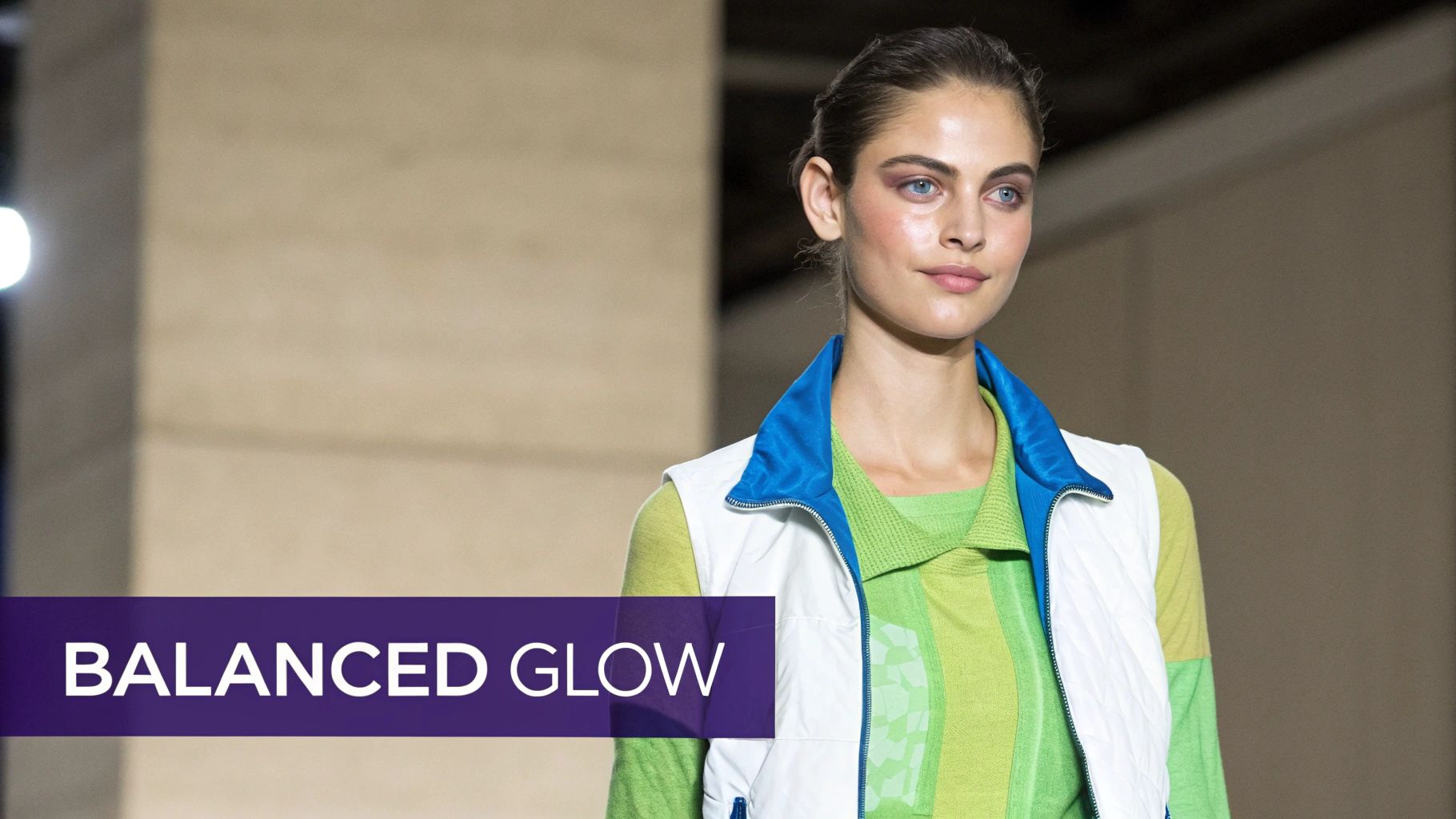
Plum purple, a deep, rich shade with red undertones, is a perfect color for olive skin. This luxurious and sophisticated color complements olive complexions beautifully. It's a jewel tone that enhances the inherent warmth of olive skin, adding depth and dimension. Unlike cooler purples, which can appear stark against olive undertones, the red in plum creates a harmonious and balanced effect.
This versatility across different intensities makes plum adaptable for various occasions and personal styles. From a soft, almost blush-like plum to a deep, dramatic shade, the options are plentiful. This adaptability also makes plum popular across different fashion seasons, although it truly shines in fall and winter.
Features and Benefits
- Deep Purple With Red Undertones: This key feature distinguishes plum from cooler purples, allowing it to harmonize with warm undertones.
- Rich, Jewel-Toned Quality: Plum adds a sense of opulence and sophistication to any look, from a simple accessory to a statement piece.
- Versatile Across Different Intensities: From soft pastels to deep, saturated hues, plum offers flexibility for various styles and occasions.
Pros
- Enhances the golden undertones in olive skin, creating a radiant glow.
- Creates a rich, sophisticated look suitable for both casual and formal settings.
- Works beautifully for evening wear and formal occasions, adding a touch of drama and elegance.
- Flatters both lighter and deeper olive complexions.
Cons
- Can appear harsh if the wrong shade is chosen (blue-based purples should be avoided).
- May require careful makeup coordination to avoid clashing.
- Can be challenging to find true plum rather than a bluish-purple.
Real-World Examples and Application
- Evening Glamour: A plum lipstick creates a sophisticated evening look. Celebrities like Eva Longoria often choose plum tones. Designer Tom Ford has also created iconic plum lipsticks designed to flatter olive undertones.
- Formal Elegance: Plum dresses are elegant choices for formal events, offering a rich and flattering alternative to classic black or navy.
- Accessorizing with Plum: Plum accessories, such as scarves, handbags, or jewelry, add rich color accents to neutral outfits, instantly elevating a simple look.
Tips for Implementation
- Choose Wisely: Opt for plums with red undertones. Hold the color up to your face in natural light to ensure it complements your skin tone.
- Metallic Pairing: Pair plum with gold jewelry to enhance warmth and create a luxurious effect.
- Makeup Magic: Try plum eyeliner to make brown eyes pop. Plum blush or bronzer near the face helps bring out golden qualities in olive skin. Makeup artist Lisa Eldridge frequently recommends plum tones for clients with olive undertones.
Plum purple has become a go-to color for individuals with olive skin. It enhances natural warmth and creates a polished, sophisticated look. By following these tips and understanding the nuances of this versatile color, anyone can incorporate plum into their wardrobe and makeup routine with confidence.
Teal: A Flattering Hue for Olive Skin
Teal, a captivating blue-green hue, stands out as an exceptional color for olive skin. Its unique ability to both contrast with and complement olive undertones sets it apart. This versatile color enhances the complexion with vibrancy and luminosity without appearing harsh, offering a sophisticated alternative to typical blues or greens.
Teal's position on the color spectrum, nestled between blue and green, allows it to enhance both the warm golden and cool green notes frequently found in olive skin tones. This creates a harmonious balance, highlighting the natural beauty of olive complexions.
Exploring the Spectrum of Teal
The intensity of teal varies, ranging from a softer aqua to a deep, almost emerald green. This spectrum provides a wide array of options for individuals with olive skin. Teal carries both cooling and warming elements, making it suitable for both warm and cool olive undertones. Whether in solid blocks of color, like a striking dress, or incorporated into patterns, teal offers styling versatility. Teal dresses, for instance, can beautifully highlight the golden undertones in olive skin. Think of the stunning teal gowns actress Freida Pinto has worn on the red carpet.
Styling With Teal: Accessories and Makeup
One of teal's key advantages is its ability to create a balanced and sophisticated look. Teal statement jewelry, for example, can add a perfect accent against neutral clothing, instantly elevating a simple outfit. For makeup enthusiasts, teal eyeliner offers a subtle yet striking definition for brown eyes, providing a fresh alternative to black or brown. Designer Monique Lhuillier often features teal in her collections, showcasing its flattering effect on olive complexions.
Navigating the Nuances of Teal
While teal offers numerous advantages, there are some potential considerations. Finding the perfect shade, striking the right balance between blue and green, might require some experimentation. Coordinating teal with specific neutrals can also take practice. Pairing teal with chocolate brown or camel creates a particularly sophisticated palette. For a deeper understanding of how undertones influence color choices, you might find this article helpful: Vein Color Significance: Health & Beauty Implications. It explains how observing vein color can provide clues to understanding undertones and selecting flattering colors like teal.
Incorporating Teal Into Your Style
Here are a few practical tips for introducing teal into your wardrobe and makeup routine:
- Brighten your complexion: Try teal near the face with a scarf, necklace, or top.
- Experiment with makeup: Use teal eyeliner instead of black or brown.
- Balance bold teal: Pair bolder teal pieces with neutral accessories.
- Start small: If unsure about a full teal garment, begin with accessories or smaller details.
Teal's growing popularity is partly thanks to makeup artists like Pat McGrath, who has created iconic teal eye looks for editorial shoots featuring olive-skinned models. Its versatility and flattering qualities make it a powerful color choice for anyone seeking to enhance their personal style. Whether you’re interested in personal styling or simply want to elevate your natural beauty, teal provides a unique and sophisticated option.
Burnt Orange: A Flattering Hue for Olive Skin
Burnt orange, a warm, inviting color residing between orange and brown, is exceptionally flattering for olive skin tones. Its earthy, autumnal nature enhances the warmth already present in olive complexions. The depth of this shade adds a sophisticated touch often lacking in brighter oranges.
This color's richness and depth truly distinguish it. Subtler and more refined than a typical bright orange, burnt orange offers greater versatility. Think of a deep, warm orange infused with brown undertones—a complex and captivating hue. This richness complements the inherent warmth and depth of olive skin.
Pros of Burnt Orange
Enhances Golden Undertones: Burnt orange brings out the golden undertones often found in olive skin, creating a radiant glow.
Harmonious with Olive Skin: The color blends beautifully with the natural warmth of olive skin for a balanced and flattering appearance.
Adds Sophistication: Unlike brighter oranges, burnt orange brings a sense of sophistication and richness to any look.
Versatile Seasonality: Ideal for fall and winter, burnt orange can be styled for year-round wear.
Cons of Burnt Orange
Potentially Overwhelming: For lighter olive skin tones, too much burnt orange can be overpowering. Start with accessories or accents and gradually incorporate larger pieces.
Requires Coordination: Careful coordination with other colors is essential to avoid clashes.
Finding the Right Shade: Locating a true burnt orange, as opposed to a standard orange, can sometimes prove challenging.
Burnt Orange: Real-World Examples and Styling Inspiration
Clothing: Burnt orange sweaters or tops provide flattering warmth, particularly in cooler months. A chunky knit sweater paired with dark wash jeans offers a cozy yet chic ensemble.
Accessories: A burnt orange scarf, handbag, or shoes can add a pop of color against navy or olive green clothing.
Makeup: Burnt orange eyeshadow adds dimension and warmth, complementing brown eyes, a common feature with olive skin.
Tips for Implementing Burnt Orange
Near the Face: Wearing burnt orange close to your face maximizes its ability to enhance your complexion.
Sophisticated Contrasts: Combine burnt orange with navy blue or deep teal for a sophisticated, high-contrast effect.
Shade Selection: Richer, more intense burnt oranges suit deeper olive skin tones, while softer shades flatter lighter olive complexions.
Makeup Balance: Pair a burnt orange outfit with neutral makeup for everyday wear, or create a dramatic look with a coordinating lip or eye for special occasions.
Burnt Orange's Rise in Popularity
Celebrities like Eva Mendes, known for her stunning olive complexion, have showcased the flattering nature of burnt orange. High-fashion designers, including Gucci, have also featured the color in their collections, emphasizing its suitability for Mediterranean skin tones, further solidifying its presence in fashion.
By following these tips and exploring various styling options, you can confidently incorporate burnt orange into your wardrobe and makeup routine. This versatile color enhances your natural beauty, adding warmth and sophistication to your style.
Olive Skin: 8-Color Comparison Guide
| Color | Complexity (🔄) | Compatibility (⚡) | Impact (📊) | Tips (💡) | Overall Appeal (⭐) |
|---|---|---|---|---|---|
| Burgundy | Bold and statement; may overwhelm if not coordinated | Works year-round; pairs well with olive tones and gold accents | Enhances natural warmth with a striking contrast | Pair with gold; start with accessories for a subtle entry | Rich, sophisticated, and elegant |
| Emerald Green | Harmonious yet can be tricky to pair | Often requires premium pieces; balances blue and green undertones | Enhances the natural glow and creates a balanced, luxurious look | Use in clothing or makeup; pair with gold or bronze | Vibrant, luxurious, and balanced |
| Coral | Bright and vibrant; demands careful balancing | Versatile across casual and formal styles; coordinates smoothly with neutrals | Brightens complexion and adds a youthful, energetic glow | Use as blush or lipstick; keep other elements neutral | Energetic, fresh, and flattering |
| Cobalt Blue | Intense and dramatic; needs confident styling | Requires neutral accents for balance; adapts to various settings | Creates dramatic contrast that makes skin appear more radiant | Apply near the face; pair with creamy or white accents | Striking, memorable, and bold |
| Mustard Yellow | Finding the right shade can be challenging; style requires precision | Earthy tone that pairs well with navy or teal for a harmonious look | Enhances golden undertones and adds a warm, spice-inspired depth | Coordinate with complementary colors; ideal for fall and winter outfits | Unique, warm, and harmonious |
| Plum Purple | Shade selection is critical; demands careful makeup coordination | May require adjustment in makeup to avoid a harsh look | Rich depth that enhances golden undertones, ideal for evening or formal wear | Use as lipstick or eyeliner; pair with gold jewelry | Sophisticated, luxurious, and elegant |
| Teal | Balancing blue-green requires precision; can be challenging to perfect | Works best when paired with neutrals or contrasting colors to balance its dual nature | Combines cooling and warming elements, adding a vibrant yet balanced glow | Incorporate in accessories or makeup; experiment with teal eyeliner for subtle emphasis | Unique, balanced, and refreshing |
| Burnt Orange | May overwhelm if used excessively; requires careful integration in styling | Earthy and versatile; pairs effectively with navy and other neutrals | Accentuates natural warmth with a rich, glowing effect that enhances skin’s golden undertones | Opt for use in sweaters or accessories; balance with neutral tones for a refined appearance | Warm, refined, and harmonious |
Styling Your Best Colors
From deep jewel tones like emerald green and plum purple to vibrant shades like coral and mustard yellow, experimenting with these eight colors can revitalize your wardrobe and makeup. Choosing colors that complement olive skin is all about enhancing your natural radiance.
The key is understanding how colors interact with your unique undertones. Warm olive skin glows with earthy tones like burnt orange and mustard yellow. Cool olive skin, on the other hand, is striking with jewel tones such as emerald green and cobalt blue.
Putting these concepts into practice is simpler than you might think. Begin by adding one or two recommended colors to your current wardrobe. Pay attention to how they make you feel and the compliments you receive.
Gradually incorporate more of these flattering shades into your outfits, and explore various combinations. Don't hesitate to experiment with accessories and makeup to complete your look.
Refining Your Palette
Developing your color palette is a continuous process. What looks best on you can change depending on the lighting, season, or even your hair color.
Remain open to exploring new shades within the families of these core colors. For example, if cobalt blue works for you, try other blues like sapphire or navy. If plum purple is a success, consider lavender or violet.
Staying informed about ongoing trends in color analysis can also be beneficial. Fashion is always evolving, so awareness of current color palettes and styles will enhance your styling knowledge.
Key Takeaways for Olive Skin Tones
Remember these important points: understand your undertones, experiment gradually, adapt your choices to the context, and be open to new shades.
These eight colors—burgundy, emerald green, coral, cobalt blue, mustard yellow, plum purple, teal, and burnt orange—provide a solid base for a wardrobe that flatters your olive skin tone and boosts your confidence.
Personalized Color Matching with AI
Want to discover even more colors that perfectly complement your complexion? AI Color Analysis offers a personalized color matching solution.
Upload a photo and receive a detailed PDF report outlining your ideal color palettes, style recommendations, and personalized advice for clothing, makeup, and more—all powered by AI Color Analysis. Discover your best colors instantly and transform your style.
Take your style to the next level with a professional analysis
You already know the theory. Now discover exactly which colors and styles enhance your personal image.
Loading...
Complete PDF report in less than 5 minutes
Your color season and personalized palette
Specific makeup and clothing recommendations
Based on professional color analysis
One-time investment:
One-time payment, no subscriptions. Instant access.